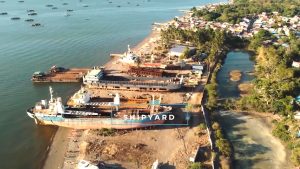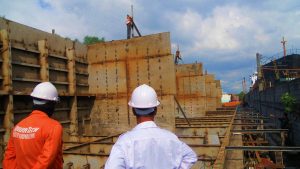Ship repair and drydocking are two vital aspects of the Philippine maritime industry that play a crucial role in maintaining the efficiency and longevity of ships. While often used interchangeably, ship repair and drydocking have distinct differences that every shipowner or operator should be aware of. This article aims to shed light on these differences, particularly in the context of ship repair and drydocking in the Philippines.
In the dynamic landscape of the Philippine maritime industry, ship repair facilities have emerged as key players, catering to both domestic and international vessels. These facilities offer a wide range of services, including routine maintenance, refurbishment, equipment upgrades, hull cleaning, and propeller repairs.
Click here and find out about our ship repair and drydocking services in the Philippines.
Defining Ship Repair in the Maritime Industry
Ship repair is a vital component of the maritime industry in the Philippines, ensuring that vessels remain seaworthy and efficient. It encompasses a range of activities aimed at maintaining, repairing, and upgrading ships to extend their lifespan and optimize their performance. Ship repair can involve tasks such as hull maintenance, engine overhauls, electrical system repairs, painting, cleaning, and retrofitting. These activities are essential for keeping vessels in compliance with international safety regulations and maintaining their operational readiness.
The ship repair process in the Philippines typically begins with an assessment of the vessel’s condition to identify any areas that require attention. This evaluation helps in determining the scope of work needed and estimating the time frame and costs involved. Skilled technicians then carry out the necessary repairs using specialized equipment and techniques specific to each task.

Defining Drydocking in the Maritime Industry
Drydocking in the Philippines is a crucial process in the maritime industry that involves removing a ship from the water for inspection, maintenance, and repairs. This essential procedure ensures that vessels remain seaworthy and meet safety regulations. During drydocking, ships are brought to specialized facilities called dry docks, where they can be safely lifted out of the water using hydraulic or floating docks. Once out of the water, the ship’s hull is thoroughly inspected for damages such as cracks, corrosion, or biofouling.
In addition to inspections, drydocking allows for various maintenance tasks to be carried out. These include cleaning and painting the hull to prevent corrosion and improve fuel efficiency. It also provides an opportunity for repairing or replacing damaged components such as propellers or rudders.

Purpose of Ship Repair
Ship repair in the Philippines is an important aspect of maintaining the maritime industry, ensuring that vessels remain in optimal condition for safe and efficient operations. The purpose of ship repair is multifaceted. First, it involves addressing any damage or wear and tear that may have occurred during the vessel’s operation. This includes repairing structural components, fixing mechanical systems, and replacing or refurbishing equipment to ensure it is functioning properly.
Second, ship repair focuses on preventive maintenance to avoid potential issues or breakdowns in the future. Regular inspections and repairs help identify any potential problems before they become major concerns, thus reducing the risk of accidents or costly downtime.
Last but not least, ship repair in the Philippines also serves an economic purpose by extending the lifespan of a vessel. By keeping ships well-maintained and operational for longer periods, owners can maximize their return on investment while minimizing capital expenditures on new vessels.
Drydocking, although related to ship repair, refers specifically to the process of taking a vessel out of water onto dry land. While some ship repairs can be conducted without drydocking through underwater inspections and repairs using divers or remotely operated vehicles (ROVs), others require more extensive work that necessitates removing the vessel from the water entirely. Drydocking provides better access to different parts of the hull and allows for comprehensive inspection as well as maintenance activities such as painting, cleaning, propeller servicing, and ballast tank cleaning, among others.
Ship repair in the Philippines plays a vital role in maintaining the safety, reliability, and longevity of vessels, such as LCTs, tugboats, or deck barges.

Purpose of Drydocking
Drydocking is a crucial process in ship repair and maintenance that involves taking a vessel out of the water for inspection, repair, and refurbishment. While both ship repair and drydocking are essential in maintaining the overall condition of a ship, they differ in terms of purpose and scale. Ship repair typically refers to the general maintenance work carried out while the vessel is still floating, such as fixing minor damages or addressing mechanical issues. On the other hand, drydocking serves as a more extensive form of ship repair that requires placing the ship in a dry dock facility.
The main purpose of drydocking is to allow for thorough inspections and repairs that cannot be easily conducted while the vessel is at sea or docked on water. Once placed in a dry dock, ships can undergo comprehensive examinations to identify any hidden damages or structural weaknesses that may have gone unnoticed during regular operations. This process often involves cleaning and painting the hull, inspecting propellers, rudders, and other underwater components, as well as conducting surveys to ensure compliance with safety regulations.
Drydocking also allows for major repairs or modifications that require extensive access to different parts of the vessel’s hull or machinery systems. From repairing damaged sections to replacing worn-out equipment or installing new technologies, this period ensures that all necessary work can be carried out efficiently without any time constraints imposed by ongoing voyages.

Key Differences Between Ship Repair and Drydocking
Ship repair and drydocking are two essential services in the Philippine maritime industry, but they serve different purposes. Ship repair refers to any maintenance or overhaul work done while a vessel is still in the water, whereas drydocking involves taking the ship out of the water and placing it in a specially constructed drydock.
One key difference between ship repair and drydocking is the scope of work that can be carried out. During ship repair, only certain types of maintenance and repairs can be performed due to limited access to certain areas of the vessel. However, during drydocking, more extensive work can be undertaken as the entire hull is accessible for inspection and repairs.
Another significant difference lies in cost and time factors. Ship repairs are generally quicker and more cost-effective since they can be carried out without disrupting normal operations or requiring additional resources such as tugs or cranes to move the vessel. On the other hand, drydocking requires careful planning and coordination as it involves taking a ship out of service for an extended period, which can result in higher costs due to the loss of revenue during this downtime.
While both ship repair and drydocking in the Philippines are crucial for maintaining vessels’ seaworthiness, they differ in terms of the scope of work that can be conducted and associated costs. Ship repair allows for limited maintenance while ships remain in operation; meanwhile, drydocking offers comprehensive inspections and repairs but requires longer downtime at higher expenses.

Importance of Regular Ship Maintenance
Ship maintenance in the Philippines is a critical aspect of ensuring the smooth operation and longevity of any vessel. One key distinction to understand is the difference between ship repair and drydocking. Ship repair refers to the routine maintenance and repairs that can be carried out while the vessel is still in operation, such as fixing minor leaks, replacing worn-out parts, or repainting certain areas. On the other hand, drydocking involves taking the ship out of water for more extensive repairs or inspections that cannot be done while afloat.
Regular ship maintenance plays a vital role in maintaining safety standards and preventing unexpected breakdowns at sea. By conducting routine inspections and repairs, potential issues can be identified early on and resolved before they escalate into major problems that may compromise the vessel’s integrity or put crew members’ lives at risk. Additionally, regular maintenance helps ensure that all equipment on board remains in good working condition, reducing the chances of system failures during crucial operations.
Moreover, adhering to a strict maintenance schedule can enhance fuel efficiency and reduce operational costs. Regularly cleaning hulls by removing accumulated marine growth prevents drag, which ultimately translates into improved fuel consumption efficiency. Furthermore, maintaining engines regularly ensures optimal performance levels while minimizing fuel wastage caused by inefficient operations due to neglect or wear and tear.
Regular ship maintenance in the Philippines is crucial for ensuring safe operations at sea while extending a vessel’s lifespan.

Are You Looking for a Ship Repair and Drydocking Company in the Philippines?
Are you in need of ship repair and drydocking services in the Philippines? Look no further than our sister company, Amaya Dockyard & Marine Services Inc. With years of experience and a track record of excellence, we are one of the leading companies in the industry. Whether you have a large commercial vessel or a smaller private yacht, Amaya Dockyard has the expertise and facilities to meet all your repair and maintenance needs.
- Email us: info@fullspeedchartering.com
- Call our 24-hour hotline: +63 939 375 3224
- Viber: +63 939 375 3224
- WhatsApp: +63 939 375 3224
- Facebook Messenger: Click here
- Click here to inquire
At Amaya Dockyard & Marine Services Inc., customer satisfaction is our top priority. We understand the importance of keeping your vessel in optimal condition to ensure its safety and efficiency. Our team of highly skilled Filipino engineers, technicians, and craftsmen is trained to handle all types of repairs, from routine maintenance to major overhauls. With state-of-the-art equipment and facilities, we can accommodate vessels of various sizes.
Summary: Ship Repair and Drydocking is an Effective Vessel Management Habit
Ship repair and drydocking are two distinct processes in vessel management that serve different purposes. Ship repair in the Philippines refers to the maintenance and refurbishment of a ship while it is still afloat, typically in a dock or shipyard. This can involve fixing mechanical issues, repairing equipment, or upgrading various systems onboard the vessel. The goal of ship repair is to ensure that the ship remains operational and meets safety standards.
Drydocking, on the other hand, involves taking the ship out of the water completely by placing it in a dry dock. This allows for more extensive work to be done as the entire hull is accessible for inspection and repairs. Drydocking is usually required for tasks such as hull cleaning and painting, propeller maintenance, rudder repairs, or major structural modifications. It also provides an opportunity to carry out routine inspections that are difficult to perform when the ship is at sea.
Understanding this distinction between ship repair and drydocking is crucial for effective vessel management in the Philippines. Shipowners need to assess whether a specific issue can be addressed through regular repairs or if it necessitates drydocking for proper resolution. By understanding these differences, operators can plan their maintenance schedules effectively and allocate resources accordingly to ensure their ships remain safe, efficient, and compliant with regulations.
